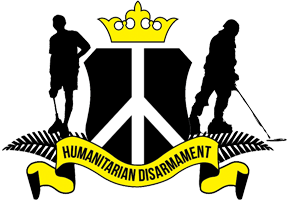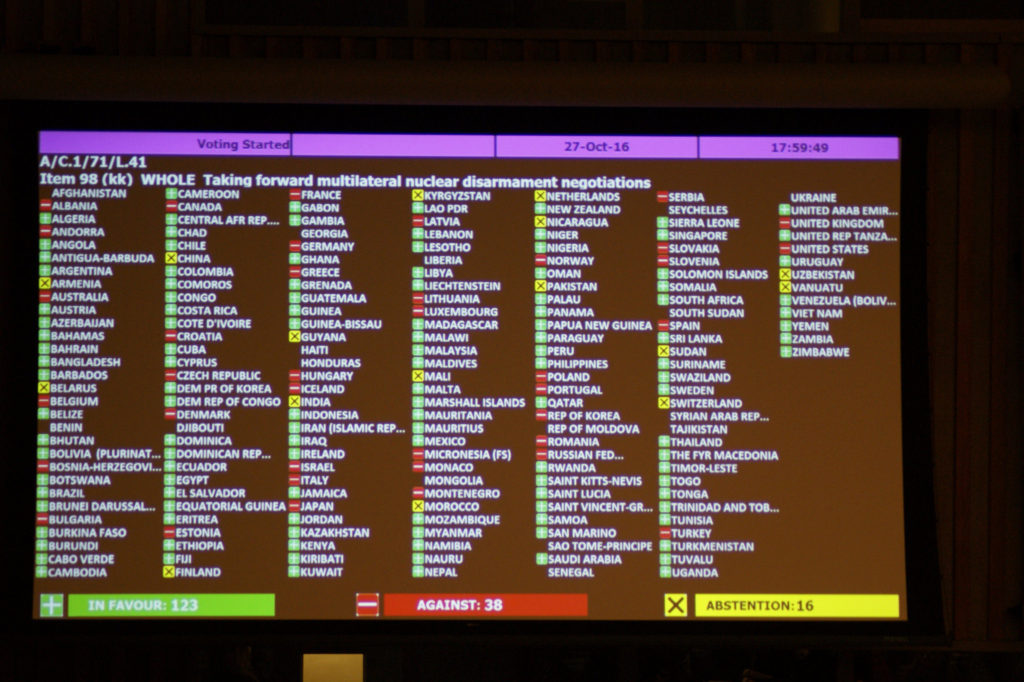On 27 October 2016 at the United Nations General Assembly, 123 countries made history when they voted in favor of a First Committee on Disarmament resolution agreeing to negotiate a ban on nuclear weapons next year.
The resolution on “taking forward multilateral nuclear disarmament” through negotiations in 2017 is the latest step for an initiative by countries united in their concern at the tremendous humanitarian consequences of any nuclear explosion. According to the resolution, the UN will convene conferences open to all member states in New York on 27-31 March and 15 June-7 July 2017 “to negotiate a legally binding instrument to prohibit nuclear weapons, leading towards their total elimination.”
Five of the world’s nuclear-armed nations voted no on the UN resolution (France, Israel, Russia, UK, US), while China, India, Pakistan abstained on the vote, and North Korea voted yes. Three dozen more non-nuclear states voted no or abstained, most of them allies and friends of nuclear weapons states sometimes referred to as “weasels.”
Resolution L.41 immediately fences these countries in by making their participation in the 2017 negotiations unwelcome and unlikely. If they do attend, they will have a hard time negatively influencing draft text as the conferences will be held under UN General Assembly rules of procedure which allow for states to vote when consensus cannot be reached.
A total of 57 nations co-sponsored the resolution, which was drafted by Austria, Brazil, Ireland, Mexico, Nigeria and South Africa. The path is now clear for these “humanitarians” to draft a strong treaty text that sets the highest possible standard banning nuclear weapons.
The US-based Arms Control Association was one of few US-based NGOs and think tanks to welcome the negotiations, describing the “strong support for negotiations on a ban treaty … as a logical international response to the growing risks and catastrophic consequences of a conflict between nuclear-armed states, the accelerating global technological nuclear arms race, and underwhelming pace of progress by the world’s nine nuclear-armed states on nuclear disarmament in recent years.”
The humanitarian initiative has the backing of key UN agencies, the International Committee of the Red Cross (ICRC), and the International Campaign to Abolish Nuclear Weapons (ICAN). The campaign believes a treaty outlawing nuclear weapons will help establish a powerful new international legal standard, stigmatize nuclear weapons and compel nations to take urgent action on disarmament.
Given the ban outcome that loomed, the US, Russia, UK, and France vigorously opposed the draft resolution in the days and weeks leading up to the vote. Yet their threats and bullying, warning of dire consequences, and derisive comments on the humanitarian initiative backfired dramatically when three-quarters of the countries voting collectively supported the draft resolution.
Norway disappointed with its no vote as it largely conceived of and launched the initiative to address the catastrophic humanitarian consequences of nuclear weapons in March 2013. Austria has since assumed leadership of the process and its representative to the UN in Geneva, Ambassador Thomas Hajnoczi, said the resolution vote shows “the time is right to create legal norms to ban weapons of mass destruction” even if “nuclear weapons states always say it’s too early for such a treaty.”
Two decades ago, Hajnoczi played a central role in another initiative aimed at addressing an indiscriminate weapon, when he helped draft the text of what became the 1997 Mine Ban Treaty prohibiting antipersonnel landmines. The humanitarian process to ban nuclear weapons adheres to many tenets of the well-trodden humanitarian disarmament path carved by the Mine Ban Treaty and followed by instruments curbing the use of child soldiers, affirming disability rights, and creating the International Criminal Court.
Not all countries will participate in the negotiations or sign immediately, but the frameworks provided by these treaties give those living in states that have not ratified something to aspire to join in the future and adhere to in the interim.
The humanitarian initiative comes 70 years after the first UN General Assembly resolution adopted in 1946 that proposed “the elimination from national armaments of atomic weapons and of all other major weapons adaptable to mass destruction.” Since then chemical weapons, landmines, and cluster munitions have been banned, but not nuclear weapons. The last multilateral nuclear disarmament instrument was negotiated in 1996 to comprehensively ban nuclear tests, but has yet to enter into legal force due to opposition by a handful of nations.
As with previous initiatives, victims and survivors actively contribute to the movement, in this case survivors of nuclear weapon detonations such as Hibakusha from Japan’s Hiroshima and Nagasaki and others harmed by nuclear testing. At the center of the humanitarian process to ban nuclear weapons is an informal partnership between like-minded governments, UN officials, Red Cross representatives, and campaigners from the highly-organized global coalition of non-governmental organizations.
Humanitarian disarmament instruments seek to set the highest possible standard, and after avoiding consensus, another key way to ensure this is by swiftly concluding the negotiations. In October 1996, Canada’s former foreign minister Lloyd Axworthy launched and led the process to prohibit landmines that concluded 14 months later in Ottawa with his signature for Canada first on the ground-breaking Mine Ban Treaty. Over the 48 hours that followed another 121 states signed, and a week later the International Campaign to Ban Landmines received the 1997 Nobel Peace Prize for its contribution to the new form of diplomacy created by the process. Axworthy reflected recently that the Canadian-led process was like “diving into a pool not to paddle but do a full 100 meter sprint.”
The resolution clearly states that the 2017 meetings will be open to “participation and contribution of international organizations and civil society representatives.” ICAN was founded in April 2007 by the Australian branch of the International Physicians for the Prevention of Nuclear War (IPPNW), recipient of the 1985 Nobel Peace Prize for its authoritative work “to create awareness about the catastrophic consequences of atomic warfare.” ICAN’s core goal has been to call for the immediate start of negotiations to create a treaty prohibiting nuclear weapons.
Today ICAN’s tiny global coordination team is functioning on perilously low funds, but the campaign is enriched and bolstered by its broad and committed membership uniting humanitarian, human rights, and other non-governmental organizations together with peace and disarmament groups, including many that have fought to abolish nuclear weapons over the past seven decades. ICAN’s executive director Beatrice Fihn previously worked for ICAN Steering Committee member Women’s International League for Peace and Freedom (WILPF), which last year commemorated its 100 year anniversary. Other campaign leaders include Peace Boat, a Japanese NGO-registered passenger ship that has traveled around the world taking Hibakusha and youth to speak about the unbearable human suffering brought by the two atomic bombs and seek support for the ban. It appears that their quest may finally be within reach.
The humanitarian process is bound for success, but will ultimately be measured by the strength of the treaty’s core provisions rather than by who signs it first.
For more information see:
- ICAN press release
- Our posts on 2016 Humanitarian Disarmament Forum (Oct. 2016) and the Humanitarian impact of nuclear weapons (Mar. 2013)


Leave a Reply